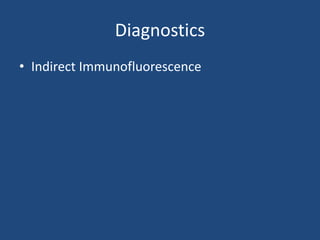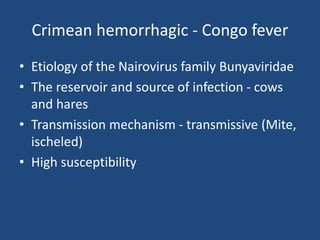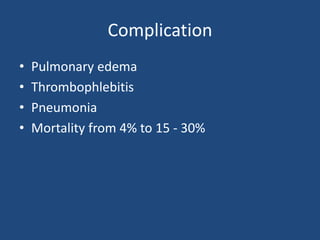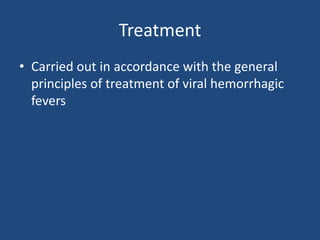Hemorrhagic fevers.ppt
- 1. Hemorrhagic Fever Prepared by: Mahmadamin Nazruloev
- 2. General characteristics −1. Etiology - −Arenaviruses −Filoviruses −Bunyaviruses −Flaviviruses 2. Belonging to natural focal disease 3. High contagiousness and lethality 4. General Pathogenesis Stage 1 - Hypercoagulation Stage 2 - progressive coagulopathy 3rd stage - the stage of defibrinogenesis and total, but not permanent fibrinolysis 4th stage - recovery stage,
- 3. General characteristics • 5. Development of hemorrhagic syndrome • 6. Intoxication • 7. High Mortality • 8. Immunity - Long and Persistent Immunity
- 4. Classification • 1. Mosquito hemorrhagic fevers: • a) yellow fever • b) Dengue hemorrhagic fever • c) Rift Valley Fever • 2. Tick-borne hemorrhagic fevers • a) Congo-Crimean hemorrhagic fever • b) Omsk hemorrhagic fever • c) Disease of the Kyasanur forest • 3. Contagious hemorrhagic fevers • a) hemorrhagic fever with renal syndrome • b) Argentinean and Bolivian hemorrhagic fever • c) lassa fever • d) fever marburg • e) Ebola
- 5. Hemorrhagic Fever with Renal Syndrome • Etiology of the Hantavirus family Bunyaviridae
- 8. Clinic • 2-3 week incubation period • The period of prodromal phenomena 2-3 days • Febrile period 5-8 days • Impaired vision 30% of cases, Soreness of the eyeballs during movements, photophobia, reduced visual acuity, objects look red, swelling of the iris, abdominal pain, hematuria. • Hemorrhagic period, rash in the form of stripes, bleeding from the gums, gross hematuria, hemorrhage in the sclera • Period of organ damage (Oligouric stage) • Polyurian Stage • Recovery period
- 13. Differential Diagnosis • Leptospirosis • Pyelonephritis • Enterovirus infection • Acute glomerulonephritis
- 16. Treatment • Strict Bed Rest • Diet number 4 without restricting protein and salt • Antiviral treatment for Virazole for 5 days • Pathogenetic treatment of 5% glucose solution, ascorbic acid • Glucocorticoids are not used.
- 17. Hantavirus Cardiopulmonary Syndrome • Incubation period 3-5 days • Cardiopulmonary stage 1-5 days • wet rales, tachycardia, tachypnea • Period of reconvalescence
- 18. Lab Test • ELISA test
- 19. Crimean hemorrhagic - Congo fever • Etiology of the Nairovirus family Bunyaviridae • The reservoir and source of infection - cows and hares • Transmission mechanism - transmissive (Mite, ischeled) • High susceptibility
- 20. Clinic • Incubation period 2-14 days • Starting Period 3-6 days • Arthralgia, myalgia, hyperemia, bleeding and hemorrhage • The height of the peak is 2 to 6 days. Hemorrhagic reactions are marked, hemolytic jaundice, renal pathology recedes into the background • Reconvalescence 1-2 months, 1-2 years
- 22. Laboratory Diagnostics • Leukopenia • Thrombocytopenia • ESR elevation • Virus isolation from blood • Reaction inhibition of indirect hemagglutination
- 23. Complication • Pulmonary edema • Thrombophlebitis • Pneumonia • Mortality from 4% to 15 - 30%
- 24. Treatment • Carried out in accordance with the general principles of treatment of viral hemorrhagic fevers
































